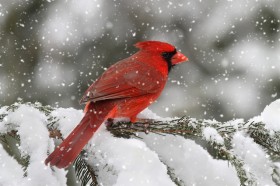Trail Report: Trails were leveled and tracks set on Wednesday. All trails have an excellent base. Currently, trails are icy.
During our annual Christmas Eve lecture, we announced that once again, Northern Cardinals are the Crossroads Bird of the Year, which actually means that on the greeting cards we received in 2013, cardinals far outnumbered other birds pictured, with chickadees coming in second and downy woodpeckers the surprising third.
Cardinals really are beautiful on greeting cards and they also have been just gorgeous outside the windows Collins Learning Center office. We see them every day, and for the last two years, they have nested in the white pine in our rock garden.
Most people assume that cardinals are native birds, but when European settlers arrived, we had no cardinals in Door County. They used to live much farther south, but the vivid red birds started to move into Wisconsin in the early 1900s and they reached Door County in 1933. Cardinals did not become common until quite recently, and last winter, many people mentioned that they had seen very little of these colorful birds.
Cardinals like to live and build their nests not in deep forests or open fields, but in the shrubby areas in between, and this habitat is becoming more common in Wisconsin. Parent birds like low evergreens and bushy shrubs for nest sites,
In the summer and fall, cardinals spend a lot of time on the ground or on very low plants, searching for food. In spring, they may eat buds, but they really like seeds and wild berries. In summer, cardinals add insects to their diets, especially when they are feeding young.
It seems that Crossroads is the perfect breeding habitat for cardinals. We have a creek, lots of “edges” and many thick shrubs. Our uplands offer lots of seeds, wild grapes and a variety of berries.
But when snow covers the ground and those low-growing plants, cardinals have trouble finding food in their favorite habitats. So they move into towns where many people maintain bird feeders.
Last year, the birds probably just stayed in their breeding areas, but I’m thinking this year, with our beautiful snow, cardinals will grace urban areas once again.
On Friday, January 10 at 3:00 will feature” Downies, Chickadees, and Cardinals.” The more you know about the social lives of these birds, the more interesting they will be.
The first program of the 2014 Master Gardener Lecture Series begins Tuesday, January 14 at 7:00 with “This Is The Green Bay Botanical Garden”. The presenter will be Susan Garot, Green Bay Botanical Gardens Executive Director who will describe the gardens and programs and give us a preview of some of their exciting plans for the future. Programs are free and open to the public.


